"Clean, season with salt and pepper and fry. Fry the onions, carrots, celery and garlic briefly. Deglaze with wine, orange and lemon juice " So this is the recipe for "Rindsbacken" or "beef cheeks", as the Austrians almost lovingly say. I am fully occupied with the hostess's deliciously prepared meal and show little interest in the wine on the table. With a mischievous smile, the host pours a deep dark red, for once from a carafe, which is rather an exception here. I can guess it: a test, a trial, an attack on my wine knowledge. In fact, the gentle invitation follows immediately: "So what?"
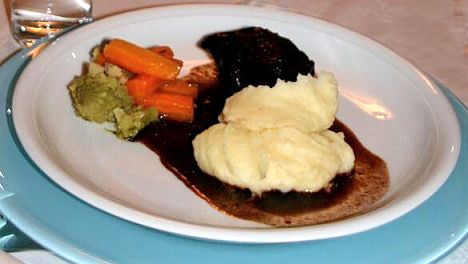 |
| Beef cheeks - a culinary exclusivity |
Actually, at the moment I feel a greater desire for the delicately fragrant, "anmächelige Bäckli" than for a mysterious wine. But decency dictates: Eye, nose, palate "Natural, dark garnet-ruby...," at least I'm not wrong. The nose is already much more difficult: "Cherries, ripe fruit, light coffee, leather, tobacco, smoke, undergrowth...", I search desperately for suitable aromas. The "Bäckli" stings my nose more and more. I guess: "southern Rhone, no, more northern - Hermitage - no idea!" Then the first sip: impressive, corsetted bouquet, very concentrated - downright "massive", at least at first. That's why I guess Châteauxneuf-du-Pape. But immediately an idiosyncratic experience forms on the palate: "warmth, body, fruit, chocolate, spice ".Spain comes to mind, Priorat. But which grape variety? No, it can't be Garnacha, nor Tempranillo, Mazuelo or Graciano. It's more like southern France, maybe Syrah, but much more concentrated, pressed differently, vinified differently than in the Languedoc or on the Rhone. In the style of.
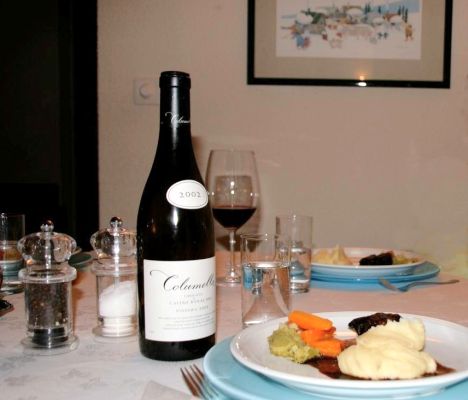 |
| Finally the mysterious bottle is on the table |
My host takes pity on me. South Africa! For the very first time I have this cult wine from the "Cape of Good Hope" in my glass. This is when I really become aware of my ignorance of the New Wine World. My own wine tradition has hardly left Europe. California has often been in my glass, but has never reached my cellar. At least I'm going to Napa Valley for the first time this autumn. Approach? Attempt at conversion? We shall see! But what about South America: Chile, Argentina; Latin America: from Mexico to Uruguay; Australia: from West to South to East; the South Pacific: New Zealand, the North and South Islands, and South Africa: Stellenbosch, Paarl, Worcester...?
My wine friends have always reported about these worlds and their wines, mostly with "shining eyes". I read travelogues in the wine magazines, I come across enthusiastic descriptions on the internet. When our daughter, barely out of high school, hitchhiked for almost a year all alone across Australia, I had nothing but Australian wines on my mind. And South Africa, which I boycotted for a long time for "noble political" reasons: Human rights!
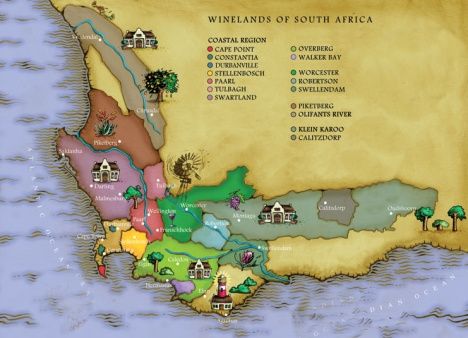 |
| Wine country South Africa |
So the "new world of wine" just kept slipping past me. I have taken note of it, but it has not really penetrated my wine knowledge or my preferences. Now, however, a great wine from the "new wine world" suddenly stands before me, completely unprepared: "Columella" by Eben Sadie, vintage 2002 from Swartland, South Africa. A young wine region, that much I still elicit from my knowledge, where mainly Steen (Chenin Blanc) is grown, but also Pinotage, Cabernet Sauvignon and the port grape Tinta Barocca.
A glance at the wine guide tells me: Columella is a Syrah wine (90%) complemented, refined with a little Mourvèdre. The berries come from seven very different sites, with different soils. The winemaker does not reveal the secret of the precise composition. His credo: "What interests me is the fantastic". Somehow I have to agree with him, the more I empty my glass with relish. Not at first, only gradually do I register the harmony of this wine, its sustainability, its backbone: rich in extract, fruity with well-integrated acidity, it seems extremely light-footed, balanced and full despite its heaviness, but does not present itself as obtrusive at all.
Admittedly, the wine fascinates me. It has many echoes of the familiar and yet remains - for me - a great unknown. At the moment, I don't want to think about it any further, I want to enjoy it. Unfortunately, I'm travelling by car - I'm not allowed to drink any more of the second bottle that is opened. What a pity! So it remains with the first two glasses, but I remember the name: Eben Sadie.
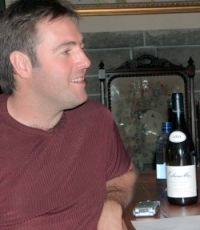 |
| Eben Sadie% famous South African winemaker% who is also at home in the Spanish Priorat. |
I do much better with the name of the wine: Columella. Lucius Lunius Moderatus Columella, the ancient author who wrote a famous work on Roman agriculture around the time of Christ's birth. In it, he postulates a storable wine without additives and sees this as the greatest criterion for quality. He also believed that wine is the only agricultural product that gains in quality through ageing. Bordeaux still invokes this ancient insight today. That is why the historical Columella (incidentally a Spaniard from Cadiz, but who lived in Italy) is well known to me. In any case, I know much more about him than I do about Eben Sadie's "Columella".
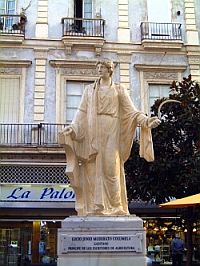 |
| Lucius Lunius Moderatus Columella. Monument in his native city of Cadiz |
After this first encounter with the wine "Columella", I did some more research. I now know: "Eben Sadie is a winemaker and oenologist who is as brilliant as he is fanatical about quality, and whom the renowned South African wine guide "John Platter" immediately hoisted into the league of 5-star producers." Or, another source: "Sadie studied agriculture and then worked for 14 years in wineries all over the world. Today, his seven top vineyards in South Africa are just one hectare each. In Spain, near Barcelona, he has another three and a half hectares. In September, when the harvest in Swartland is done and the wine matures in peace, he travels with his family to Spain for a quarter of a year."
You can look all this up in reference books or google it on the internet. But what you can't google is your personal acquaintance with wine, your own experience of wine fantasies, in which so much that is familiar comes up: northern Rhone, Spain, southern France, even a little Bordeaux (in terms of vinification) and yet embodies a whole new world, a new wine world.
Ashamedly, I realise: I know very little about this - compared to the "traditional wine world"; I have hardly any experience in it; I have not written a single column about it so far.
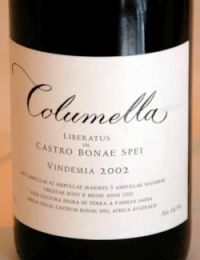 |
| Columella 2002 from South Africa |
I don't have to reorganise my wine cellar just because there are good wines elsewhere (than in the Bordelais), in other countries, on other continents. It is enough to take note of them and gain experience. Maybe I'll be invited to a culinary feast once again: beef cheeks with mashed potatoes and distinctive vegetables. But then I won't let that stop me and I will also give the wine what it deserves. Recognition and respect. Even if it is no longer the cult wine Columella, but some good, interesting wine from wine regions that I have hardly noticed and therefore hardly know.
Sincerely
Yours/Yours
Peter (Züllig)